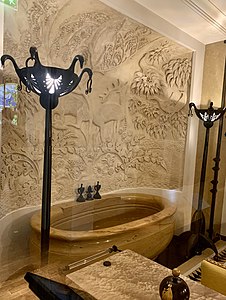About this product
Art Deco was not a single style, but a collection of different and sometimes contradictory styles. In architecture, Art Deco was the successor to and reaction against Art Nouveau, a style which flourished in Europe between 1895 and 1900, and also gradually replaced the Beaux-Arts and neoclassical that were predominant in European and American architecture. In 1905 Eugène Grasset wrote and published Méthode de Composition Ornementale, Éléments Rectilignes,[56] in which he systematically explored the decorative (ornamental) aspects of geometric elements, forms, motifs and their variations, in contrast with (and as a departure from) the undulating Art Nouveau style of Hector Guimard, so popular in Paris a few years earlier. Grasset stressed the principle that various simple geometric shapes like triangles and squares are the basis of all compositional arrangements. The reinforced-concrete buildings of Auguste Perret and Henri Sauvage, and particularly the Théâtre des Champs-Élysées, offered a new form of construction and decoration which was copied worldwide.[57]
In decoration, many different styles were borrowed and used by Art Deco. They included pre-modern art from around the world and observable at the Musée du Louvre, Musée de l’Homme and the Musée national des Arts d’Afrique et d’Océanie. There was also popular interest in archaeology due to excavations at Pompeii, Troy, and the tomb of the 18th dynasty Pharaoh Tutankhamun. Artists and designers integrated motifs from ancient Egypt, Africa, Mesopotamia, Greece, Rome, Asia, Mesoamerica and Oceania with Machine Age elements.[58][59][60][61][62][63]
Other styles borrowed included Russian Constructivism and Italian Futurism, as well as Orphism, Functionalism, and Modernism in general.[34][58][64][65] Art Deco also used the clashing colours and designs of Fauvism, notably in the work of Henri Matisse and André Derain, inspired the designs of art deco textiles, wallpaper, and painted ceramics.[34] It took ideas from the high fashion vocabulary of the period, which featured geometric designs, chevrons, zigzags, and stylized bouquets of flowers. It was influenced by discoveries in Egyptology, and growing interest in the Orient and in African art. From 1925 onwards, it was often inspired by a passion for new machines, such as airships, automobiles and ocean liners, and by 1930 this influence resulted in the style called Streamline Moderne.[66]
Style of luxury and modernity[edit]
-
The boudoir of fashion designer Jeanne Lanvin (1922–25) now in the Museum of Decorative Arts, Paris, France
-
An Art Deco study by the Paris design firm of Alavoine, now in the Brooklyn Museum, New York City, N.Y. (1928–30)
-
Glass Salon (Le salon de verre) designed by Paul Ruaud with furniture by Eileen Gray, for Madame Mathieu-Levy (milliner of the boutique J. Suzanne Talbot), 9, rue de Lota, Paris, 1922 (published in L’Illustration, 27 May 1933)
Art Deco was associated with both luxury and modernity; it combined very expensive materials and exquisite craftsmanship put into modernistic forms. Nothing was cheap about Art Deco: pieces of furniture included ivory and silver inlays, and pieces of Art Deco jewellery combined diamonds with platinum, jade, coral and other precious materials. The style was used to decorate the first-class salons of ocean liners, deluxe trains, and skyscrapers. It was used around the world to decorate the great movie palaces of the late 1920s and 1930s. Later, after the Great Depression, the style changed and became more sober.
A good example of the luxury style of Art Deco is the boudoir of the fashion designer Jeanne Lanvin, designed by Armand-Albert Rateau (1882–1938) made between 1922 and 1925. It was located in her house at 16 rue Barbet de Jouy, in Paris, which was demolished in 1965. The room was reconstructed in the Museum of Decorative Arts in Paris. The walls are covered with moulded lambris below sculpted bas-reliefs in stucco. The alcove is framed with columns of marble on bases and a plinth of sculpted wood. The floor is of white and black marble, and in the cabinets decorative objects are displayed against a background of blue silk. Her bathroom had a tub and washstand made of sienna marble, with a wall of carved stucco and bronze fittings.[67]
By 1928 the style had become more comfortable, with deep leather club chairs. The study designed by the Paris firm of Alavoine for an American businessman in 1928–30, is now in the Brooklyn Museum.
By the 1930s, the style had been somewhat simplified, but it was still extravagant. In 1932 the decorator Paul Ruaud made the Glass Salon for Suzanne Talbot. It featured a serpentine armchair and two tubular armchairs by Eileen Gray, a floor of mat silvered glass slabs, a panel of abstract patterns in silver and black lacquer, and an assortment of animal skins
















